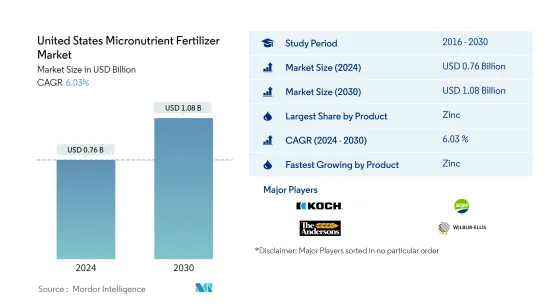Need help finding what you are looking for?
Contact Us
PUBLISHER: Mordor Intelligence | PRODUCT CODE: 1440513

PUBLISHER: Mordor Intelligence | PRODUCT CODE: 1440513
United States Micronutrient Fertilizer - Market Share Analysis, Industry Trends & Statistics, Growth Forecasts (2024 - 2030)
PUBLISHED:
PAGES: 80 Pages
DELIVERY TIME: 2-3 business days
SELECT AN OPTION
The United States Micronutrient Fertilizer Market size is estimated at USD 0.76 billion in 2024, and is expected to reach USD 1.08 billion by 2030, growing at a CAGR of 6.03% during the forecast period (2024-2030).

Key Highlights
- Largest Segment by Type - Zinc : Zinc deficiency is common in the Atlanta, Columbia, Austin, and Oklahoma states of the United States. Zinc deficiency is prevalent in orchards, maize, and wheat.
- Fastest growing segment by Type - Zinc : The common Zinc deficiency in the Atlanta, Columbia, Austin, and Oklahoma states of the United States is driving the increased adaption of Zinc application by farmers.
- Largest Segment by Crop Type - Field Crops : Field crops dominate the fertilizers market in the US due to the large cultivation area in the country. Field crops account for more than 95% of the total crop area.
- Largest segment by Application Mode - Foliar : Foliar spraying can quickly address micronutrient deficiency as the fertilizer is directly sprayed on plant leaves. The micronutrients directly act on the plant foliage.
US Micronutrient Fertilizer Market Trends
Zinc is the largest segment by Product.
- Zinc dominated the micronutrient fertilizer market in the country and accounted for about 40.1% of the total market value in 2021. Zinc consumption alone accounts for 37.7% of total volume in 2022.
- Manganese accounted for about 17.3% of the market value in 2021. Manganese is an essential nutrient that plays an important role in root growth, as an activator of enzymes, and is also involved in photosynthesis. The normal concentration of manganese ranges from 20ppm to 300 ppm in plants. When it falls below 15 to 20 ppm, it is considered deficient.
- In most agricultural soils, iron occurs in large quantities, and total iron concentrations can be 50 thousand times the crop's annual demand. However, different environmental and soil factors inhibit the iron availability to crops. Iron accounted for about 24.2% of the total market value in 2021.
- Copper is required for many enzymatic activities in plants and for chlorophyll and seed production. Copper deficiency is most likely to occur in field crops such as wheat, barley, oats, and vegetable crops. In the United States, more than 95.0% of agricultural land is occupied by field crops, and the copper fertilizer market is anticipated to grow during the forecast period.
- Micronutrients play an important role in many plant metabolic activities, such as cell wall formation, pollen formation, germination, chlorophyll production, nitrogen fixation, and synthesis of essential parts of proteins. Even though micronutrient fertilizers are required in less quantity, they are important for balanced crop nutrition. Hence the micronutrient fertilizer market is anticipated to grow during the forecast period.
US Micronutrient Fertilizer Industry Overview
The United States Micronutrient Fertilizer Market is fairly consolidated, with the top five companies occupying 127.12%. The major players in this market are Koch Industries Inc., Sociedad Quimica y Minera de Chile SA, The Andersons Inc.,, Wilbur-Ellis Company LLC and Yara International ASA (sorted alphabetically).
Additional Benefits:
- The market estimate (ME) sheet in Excel format
- 3 months of analyst support
Product Code: 92564
TABLE OF CONTENTS
1 EXECUTIVE SUMMARY & KEY FINDINGS
2 REPORT OFFERS
3 INTRODUCTION
- 3.1 Study Assumptions & Market Definition
- 3.2 Scope of the Study
- 3.3 Research Methodology
4 KEY INDUSTRY TRENDS
- 4.1 Acreage Of Major Crop Types
- 4.2 Average Nutrient Application Rates
- 4.3 Regulatory Framework
- 4.4 Value Chain & Distribution Channel Analysis
5 MARKET SEGMENTATION
- 5.1 Product
- 5.1.1 Boron
- 5.1.2 Copper
- 5.1.3 Iron
- 5.1.4 Manganese
- 5.1.5 Molybdenum
- 5.1.6 Zinc
- 5.1.7 Others
- 5.2 Application Mode
- 5.2.1 Fertigation
- 5.2.2 Foliar
- 5.2.3 Soil
- 5.3 Crop Type
- 5.3.1 Field Crops
- 5.3.2 Horticultural Crops
- 5.3.3 Turf & Ornamental
6 COMPETITIVE LANDSCAPE
- 6.1 Key Strategic Moves
- 6.2 Market Share Analysis
- 6.3 Company Landscape
- 6.4 Company Profiles
- 6.4.1 Haifa Group Ltd
- 6.4.2 Koch Industries Inc.
- 6.4.3 Nouryon Cooperatief UA
- 6.4.4 Sociedad Quimica y Minera de Chile SA
- 6.4.5 The Andersons Inc.,
- 6.4.6 The Mosaic Co.
- 6.4.7 Wilbur-Ellis Company LLC
- 6.4.8 Yara International ASA
7 KEY STRATEGIC QUESTIONS FOR FERTILIZER CEOS
8 APPENDIX
- 8.1 Global Overview
- 8.1.1 Overview
- 8.1.2 Porter's Five Forces Framework
- 8.1.3 Global Value Chain Analysis
- 8.1.4 Market Dynamics (DROs)
- 8.2 Sources & References
- 8.3 List of Tables & Figures
- 8.4 Primary Insights
- 8.5 Data Pack
- 8.6 Glossary of Terms
Have a question?


SELECT AN OPTION
Have a question?


Questions? Please give us a call or visit the contact form.
